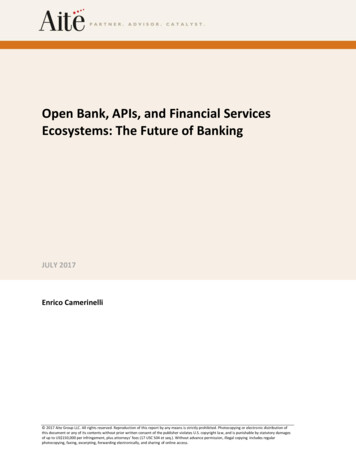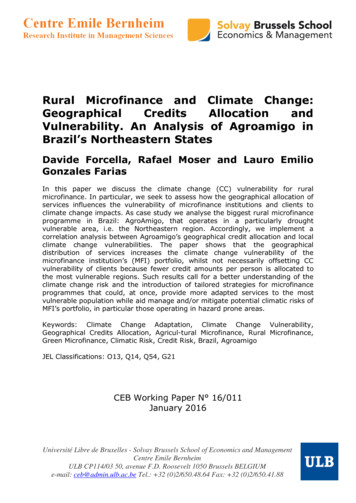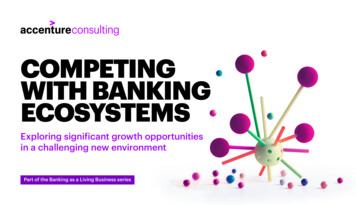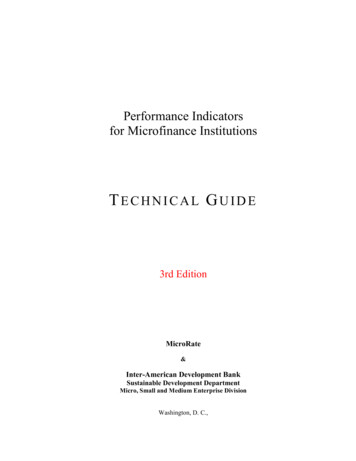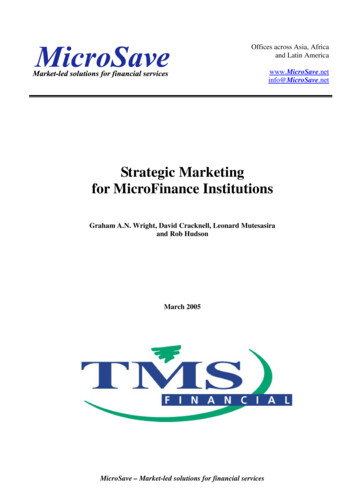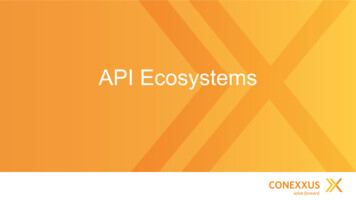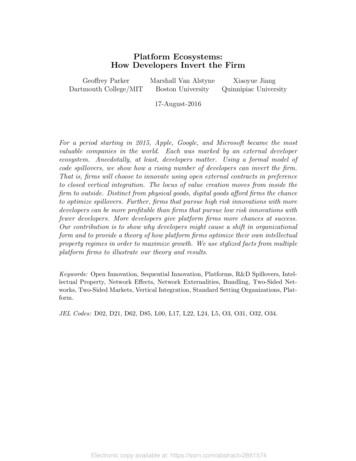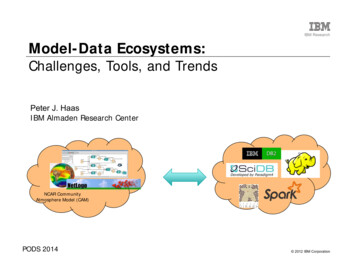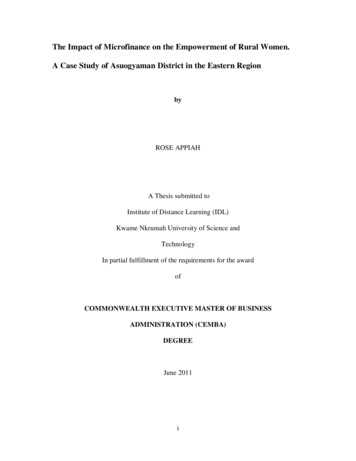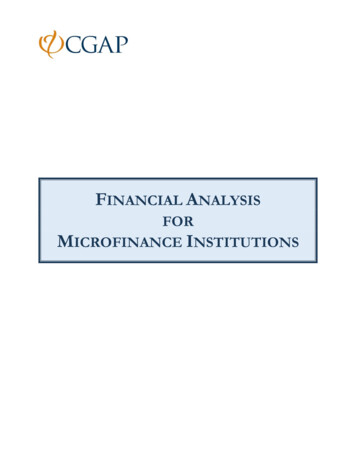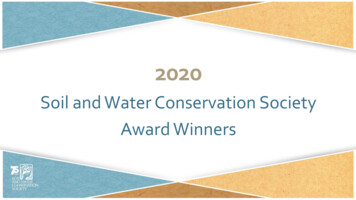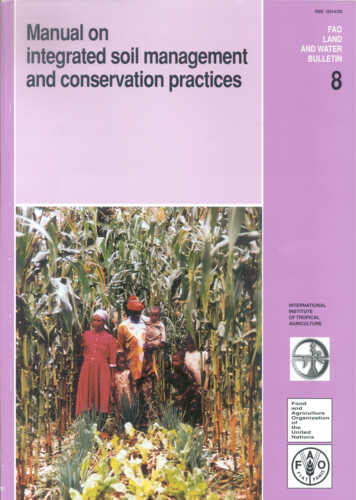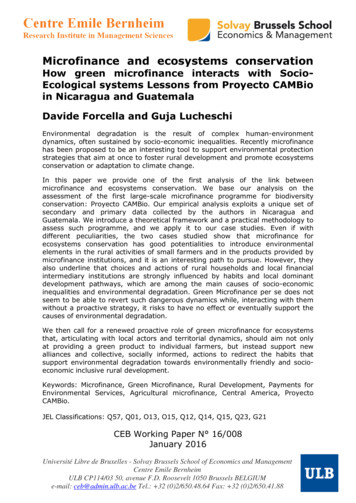
Transcription
Microfinance and ecosystems conservationHow green microfinance interacts with SocioEcological systems Lessons from Proyecto CAMBioin Nicaragua and GuatemalaDavide Forcella and Guja LucheschiEnvironmental degradation is the result of complex human-environmentdynamics, often sustained by socio-economic inequalities. Recently microfinancehas been proposed to be an interesting tool to support environmental protectionstrategies that aim at once to foster rural development and promote ecosystemsconservation or adaptation to climate change.In this paper we provide one of the first analysis of the link betweenmicrofinance and ecosystems conservation. We base our analysis on theassessment of the first large-scale microfinance programme for biodiversityconservation: Proyecto CAMBio. Our empirical analysis exploits a unique set ofsecondary and primary data collected by the authors in Nicaragua andGuatemala. We introduce a theoretical framework and a practical methodology toassess such programme, and we apply it to our case studies. Even if withdifferent peculiarities, the two cases studied show that microfinance forecosystems conservation has good potentialities to introduce environmentalelements in the rural activities of small farmers and in the products provided bymicrofinance institutions, and it is an interesting path to pursue. However, theyalso underline that choices and actions of rural households and local financialintermediary institutions are strongly influenced by habits and local dominantdevelopment pathways, which are among the main causes of socio-economicinequalities and environmental degradation. Green Microfinance per se does notseem to be able to revert such dangerous dynamics while, interacting with themwithout a proactive strategy, it risks to have no effect or eventually support thecauses of environmental degradation.We then call for a renewed proactive role of green microfinance for ecosystemsthat, articulating with local actors and territorial dynamics, should aim not onlyat providing a green product to individual farmers, but instead support newalliances and collective, socially informed, actions to redirect the habits thatsupport environmental degradation towards environmentally friendly and socioeconomic inclusive rural development.Keywords: Microfinance, Green Microfinance, Rural Development, Payments forEnvironmental Services, Agricultural microfinance, Central America, ProyectoCAMBio.JEL Classifications: Q57, Q01, O13, O15, Q12, Q14, Q15, Q23, G21CEB Working Paper N 16/008January 2016Université Libre de Bruxelles - Solvay Brussels School of Economics and ManagementCentre Emile BernheimULB CP114/03 50, avenue F.D. Roosevelt 1050 Brussels BELGIUMe-mail: ceb@admin.ulb.ac.be Tel.: 32 (0)2/650.48.64 Fax: 32 (0)2/650.41.88
Microfinance and ecosystems conservationHow green microfinance interacts with Socio-Ecological systemsLessons from Proyecto CAMBio in Nicaragua and Guatemala!Davide Forcella1 (CERMi-ULB)Guja Lucheschi!!Abstract:Environmental degradation is the result of complex human-environment dynamics, often sustainedby socio-economic inequalities. Recently microfinance has been proposed to be an interesting toolto support environmental protection strategies that aim at once to foster rural development andpromote ecosystems conservation or adaptation to climate change.In this paper we provide one of the first analysis of the link between microfinance and ecosystemsconservation. We base our analysis on the assessment of the first large-scale microfinance programme for biodiversity conservation: Proyecto CAMBio. Our empirical analysis exploits a uniqueset of secondary and primary data collected by the authors in Nicaragua and Guatemala. We introduce a theoretical framework and a practical methodology to assess such programme, and weapply it to our case studies. Even if with different peculiarities, the two cases studied show that microfinance for ecosystems conservation has good potentialities to introduce environmental elements in the rural activities of small farmers and in the products provided by microfinance institutions, and it is an interesting path to pursue. However, they also underline that choices and actionsof rural households and local financial intermediary institutions are strongly influenced by habitsand local dominant development pathways, which are among the main causes of socio-economicinequalities and environmental degradation. Green Microfinance per se does not seem to be ableto revert such dangerous dynamics while, interacting with them without a proactive strategy, it risksto have no effect or eventually support the causes of environmental degradation.We then call for a renewed proactive role of green microfinance for ecosystems that, articulatingwith local actors and territorial dynamics, should aim not only at providing a green product to individual farmers, but instead support new alliances and collective, socially informed, actions to redirect the habits that support environmental degradation towards environmentally friendly and socio-economic inclusive rural development.!Keywords: Microfinance, Green Microfinance, Rural Development, Payments for EnvironmentalServices, Agricultural microfinance, Central America, Proyecto CAMBio.!JEL codes: Q57, Q01, O13, O15, Q12, Q14, Q15, Q23, G21!!!!!!!1davide.forcella@yahoo.it!1
!!!!IntroductionThe current market economy contributes to material wealth for part of the world population, but atthe same time it sustains socio-economic inequalities (Wade, 2002; UNIneq, 2013) and environmental degradation (MEA, 2005; FRA, 2010). Climate Change is one of the many examples ofthese side effects (AR5, 2013 ; AR5, 2014): it is caused by the human economic activities that arepart of an unsustainable development model and it affects more the ones that contributed the leastto it: the rural poor in developing countries.In the modern development discourse, environmental degradation is often seen as a market externality, because costs and benefits related to environment conservation are not considered in economic transactions: there is no owner of the environment, neither a clear price for it. Payments forEnvironmental Services (PES), like the international CO2 market, reward practices that provideenvironmental services (ES) to humans assigning a price and owner for ES. PES are often claimedto be effective financial mechanisms to internalize environmental externalities into economic transactions and efficiently allocate the optimum amount of ES and environmental capital needed byhumans (Ferraro and Simpson, 2002).Moreover in developing countries environmental degradation is often linked to poverty and socioeconomic inequalities (Hall et. al., 2008). The lack of financial capital prevents micro-entrepreneursto invest in more efficient and less polluting technologies and activities, while the lack of humancapital often constraints poor households to old inefficient traditional practices and technologiesand precludes the undertaking of more environmentally friendly or economically rewarding activities. A popular strategy pushed forward by the modern development discourse to offset such barriers is “microfinance plus” (Sievers and Vandenberg 2007 ; Bastiaensen and Marchetti, 2011): amix of microfinance (MF) services for financial inclusion, and technical assistance (TA) to improvepractices, choices and possibilities for poor households and foster their socio-economic empowerment.In particular, MF plus programmes for ecosystems conservation have very recently started to enterin the development agenda; some programmes have been already discussed and implemented(EcoMicro; MebA; PCAMBio; PC, 2014; Forcella, 2012; Lucheschi, 2014; Cranford and Mourato,2014 ; Huybrechs et. al. 2015, Forcella and Huybrechs, 2015). They aim at the triple bottom line:profit-people-planet, and to foster environmentally friendly rural development, biodiversity andecosystem conservation and support Climate Change adaptation mechanisms at household level.More broadly, microfinance strategies that pursue a triple bottom line – not only related to ecosystems or climate change, but also to access to clean energy, energy efficient devices, green policies, environmental risk management, etc. – have recently attracted much attention and are generally referred as “green microfinance” (Hall, 2008; Schuite and Pater, 2008; Allet, 2014).In this paper we would like to provide one of the first analysis of the outcomes and procedures ofsuch programmes reviewing the implementation of Proyecto CAMBio: the first large scale programme that combines MF, TA, partial guaranty, and PES, with the aim of fostering biodiversityconservation and environmentally friendly land-use practices. The programme has been implemented in Central America between 2007 and 2013.We exploit a unique set of primary and secondary data collected by the two authors in Nicaraguaand Guatemala, and in particular 174 one to one interviews with clients, but also loan officers,managers of microfinance institutions (MFIs) and other relevant actors.The aim of this paper is twofold: at theoretical level we would like to provide a framework based onthe complex-system theory (Ramalingam and Jones, 2008; Ambrosio-Albalá and Bastiaensen,2010), and the habits-development pathways analysis (Hiedanpaa and Bromley, 2014; Bastiaensen et. al., 2015) to discuss potentialities and outcomes of microfinance plus programmes forecosystem conservation at territorial level. At the practical level we would like to introduce a!2
methodology and a simple framework that could be used by other researchers, consultants, development agencies and so on to analyse pro and cons of other similar programmes.We apply such theoretical framework and practical methodology to Proyecto CAMBio in Nicaraguaand Guatemala. We conclude that MF programmes for ecosystems conservation have good potentialities to contribute to the introduction of environmental practices into rural activities of smallfarmer and into products and procedures of MFIs. However, we observe the limitations of suchtools, and more in general of incentives targeting individual actors, to revert the causes of unequaldevelopment and environment degradation. In particular we point out that without a clear set of collective and territorial strategies, embedded in the local socio-economic dynamics, the potentialbeneficial outcomes of such programmes risk to be lost, and the operations of the programmesthemselves risk to indirectly support a « business as usual scenario » and hence the destructive,socially excluding dynamics that they aim to offset.We then suggest a more informed and community embedded implementation of such programmeswith the objective to reshape the interactions among the actors of the socio-environmental systemtoward a more inclusive and environmentally friendly socio-economic development. We argue thatarticulation with local actors and tailored actions fostering new alliances among community members with clear territorial strategies could be the first way to make these programmes more effective.We wish that similar forthcoming programmes could capitalise on the lessons learnt in this firstprogramme, and hence fulfill their real potentialities in term of environmentally friendly and sociallyinclusive rural development of poor communities.The rest of the paper is organized as follow: in section 1 we present out theoretical frameworkused in the rest of the paper, introducing the concept of socio-environmental system, its complexdynamics, and the role played by habits and development pathways in the choices and actions ofinstitutions and households. We also formulate our research questions. In section 2 we introduce apractical framework to analyse and assess microfinance programmes that aim to ecosystems conservation, and we define our methodology to investigate the research questions. In section 3 wevery shortly describe the microfinance for ecosystem programme we discuss in the paper: Proyecto CAMBio. In section 4 we presents our data, secondary and primary, and their collection. In section 5 we present our data analysis and results. We finally conclude in section 6. In the appendixwe group the description of the institutions implementing the programme.1. Theoretical frameworkIn this section we would like to provide the theoretical framework for our analysis of MF for ecosystems. Our framework is developed starting from a complex system approach to the human-environmental dynamics as presented in (Ramalingam and Jones, 2008; Ambrosio-Albalá and Bastiaensen, 2010), and underlines the important role played by habits and development pathways ininfluencing the choices and investments of poor rural populations targeted by PES or MF programmes as discussed in (Hiedanpaa and Bromley, 2014; Bastiaensen et. al., 2015).We live in a complex world, however its complexity does not appear such a heavy burden in ourdaily life: our day-to-day decisions, actions and choices look indeed quite simple. Every day wealmost unconsciously perform choices (among which economic choices: what to buy, where to buyit, etc.) that would require a very complex evaluation of a huge number of interlinked benefits andrisks. The simplifying assumption of an individual economic actor choosing among the various opportunities to maximise its wealth would imply that everyone would have the capacity and time tospend calculating the potential benefits, loses and risks of its choices among an incalculable number of different possibilities (Hiedanpaa and Bromley, 2014). If this were true, decisions making andactions would be exceedingly slow and highly inaccurate due to the impossibility for a single actorto grab and understand the complexity of the opportunities opened by every choice. This visionindeed underestimates the role played by habits and beliefs (Hiedanpaa and Bromley, 2014) anddevelopment pathways (Bastiaensen et. al., 2015; Huybrechs et. al., 2015) that instead guide andlimit our choices. They indeed provide a simplified (even if constrained) framework inside the complex set of benefits and risks open by every potential choice. Habits and development pathways!3
are the social and historical assets that reduce the possibilities of choices to the ones that are socially supported or accepted and or empirically proven (or believed) to be rewarding or less risky.In the paper, we will mean by habits the influence of past personal, familiar, peers and societal actions, experiences and their outcomes, on the present decisions of a socio-economic actor(households, enterprises, financial intermediaries, etc.). Something that could be simply phrasedas: “.I do it, because I used to do so.”, or “. I do it, because it's used to or it is sociallyaccepted.”,By development pathways we mean the set of local economic activities inside a community or aregion that have proven, or that are believed, to be economically and or socially rewarding andhence influence the livelihoods strategies of households, enterprises, institutions and other actorsoperating in the same area.Habits and development pathways support beliefs and rules of actions that are deeply rooted indaily choices, and that, in a circular path, strengthen habits and development pathways themselves. They are emerging properties of the socio-ecological system (SES), in which householdslive and take decisions. The SES is the outcome of complex relational processes among humansand the environment, mediated by social institutions in particular times and geographical places. Itis influenced by and it generates local culture, values, power relations and formal and informalrules. Habits and development pathways emerge as macroscopic results of such complex dynamics. SES is the background inside which people make decisions.People adapt to habits and local value and, under the constraints and opportunities provided bylocal and international development pathways, they use them as direct or indirect tools to take decisions. Such background in which people (see economic actors) act is useful because it simplifychoices, it builds on past experiences about what works and what does not, reduces risk, linkspeople choices to existing market opportunities and chains, and supports social acceptance ofchoices and actions. However it also limits people, social and environmental opportunities, because there could exist more rewarding and environmentally friendly choices that are not undertaken because not supported or recognized by present local habits and, or local/international development pathways. The utility and constraints of habits and development pathways are evenstronger among population and people that have less economic-social-human-physical capital, thatcould allow to partially overcome the limitations of a “business as usual behaviour” and developnew decisions and livelihood strategies: poor rural people in developing countries.As example, we could think to a poor farmer in Nicaragua who practices its rural activities according to what he learnt from his father. Such practices are his main assets and allow him to survive(and sometimes progress) and they reduce his risk. However these livelihood strategies areshaped by a reduced set of local opportunities, uneven power structures, reduced market access,which way too often frequently constrain him in the lowest level of buyers driven value chains andforce him into poverty traps. Indeed, old technologies and reduced financial capital often constrainhim to cultivate staple crops, or produce for example low quality cacao or milk that do not meet thequality standards required to access better prices: such as sell the cacao to a local cooperativethat has access to international organic market; or sell the milk to a local cooperative that has access to national distribution chains or higher prices due to shorter local value chains. Moreover, thegeographical location of his farm (due to land market forces), far away from roads, is a physicallimitation that prevents him to access to more rewarding markets. At the same time the need forland and the impossibility to buy it cause too expensive, pushes him towards cheaper areas, usually towards the agricultural frontier. The land he sold is often bought by wealthier farmers who use itfor profitable activities such as extensive cattle raising (one of the dominant pathways in the region), which is, however, environmentally unsustainable. While the poorer farmers, like him, areforced to move to cheaper and more far-fetched lands, cut trees, burn vegetation, before establishing there. In this way they contribute to environmental degradation and they are even more excluded by actual socio-economic opportunities, while richer farmer cumulate wealth and invest inenvironmentally destructive practices. Hence the SES sustains and reinforce a socially un-evenand environmentally destructive cycle.It is important to remark that the influences of the complex SES are not limited to individual households but they also refer to institutions, groups, societies (actors in general) who are influenced byhabits, beliefs and development pathways in their choices and actions. Indeed, it is reasonable toconclude that it is not really possible to separate a single economic actor (see for example a per-!4
son or an institution) or a single action from the environment where it lives and acts. The conceptof an actor separated by its SES is indeed by itself an abstraction (that could be more or less accurate according to situations), because the action of the SES on the actor strongly influence itschoices, while the actions of the individual actors are themselves mediated by SES. Any externalintervention is then deemed to interact with the complex socio-economic environmental dynamicsof the SES.The sentences of the famous physicist of last century, Niels Bohr, one of the father of quantummechanics, are
Davide Forcella and Guja Lucheschi Environmental degradation is the result of complex human-environment dynamics, often sustained by socio-economic inequalities. Recently microfinance has been proposed to be an interesting tool to support environmental protection strategies that aim a
